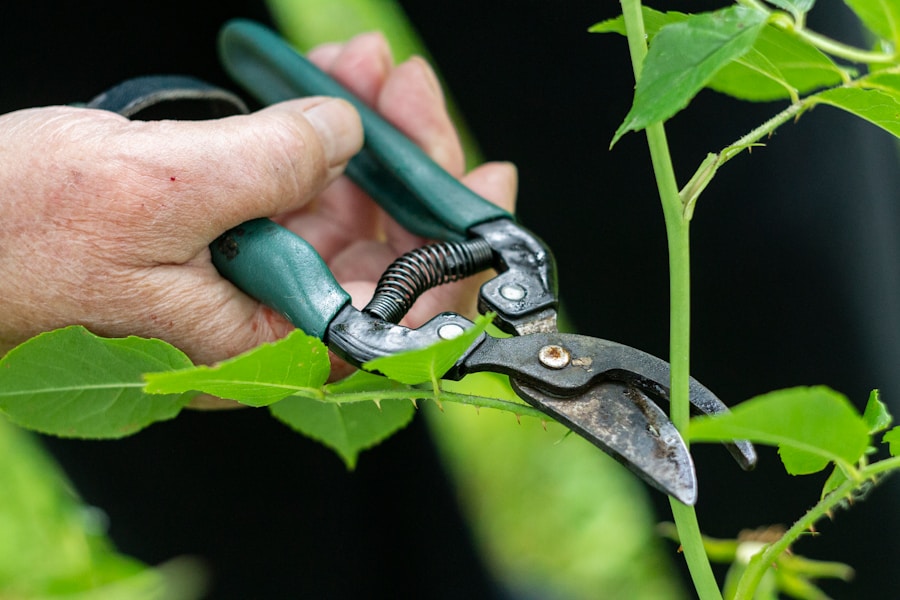Pruning is an essential practice for maintaining the health and appearance of plants. It involves the selective removal of certain parts of a plant, such as branches, buds, or roots, to promote healthy growth and improve the overall appearance of the plant. Pruning is important for several reasons. First, it helps to remove dead or diseased branches, which can prevent the spread of disease and improve the overall health of the plant. Additionally, pruning can help to shape the plant and encourage the growth of new branches and flowers. By removing old or overgrown branches, pruning can also improve air circulation and sunlight exposure, which are essential for the health of the plant. Overall, pruning is a crucial practice for maintaining the health and appearance of plants, and it is important for gardeners to understand the best times and techniques for pruning different types of plants.
Pruning is also important for promoting the overall health and longevity of plants. By removing dead or diseased branches, pruning can prevent the spread of disease and improve the overall health of the plant. Additionally, pruning can help to shape the plant and encourage the growth of new branches and flowers. By removing old or overgrown branches, pruning can also improve air circulation and sunlight exposure, which are essential for the health of the plant. Overall, pruning is a crucial practice for maintaining the health and appearance of plants, and it is important for gardeners to understand the best times and techniques for pruning different types of plants.
Identifying the Best Times to Prune
The best time to prune a plant depends on its specific type and the desired outcome. In general, it is best to prune most plants during their dormant season, which is typically in late winter or early spring. Pruning during this time allows the plant to recover more quickly and reduces the risk of disease or pest infestation. However, there are some exceptions to this rule. For example, spring-flowering shrubs should be pruned immediately after they have finished flowering, as they set their flower buds in the previous year’s growth. Pruning these shrubs at the wrong time can result in a loss of flowers for the following year. Similarly, some plants, such as roses, benefit from a second round of pruning in late summer to encourage a second flush of blooms. It is important for gardeners to research the specific needs of each plant before deciding on the best time to prune.
In addition to considering the specific needs of each plant, it is also important to take into account the local climate and weather conditions when deciding on the best time to prune. Extreme temperatures or weather events can stress plants and make them more susceptible to damage from pruning. It is best to wait until conditions are mild and stable before pruning, to minimize stress on the plant and promote healthy growth. Overall, understanding the best times to prune is essential for promoting the health and appearance of plants.
Mastering the Techniques for Pruning Different Types of Plants
Different types of plants require different pruning techniques to promote healthy growth and maintain their appearance. For example, shrubs and trees should be pruned to remove dead or diseased branches, improve air circulation, and shape the plant. When pruning shrubs and trees, it is important to make clean cuts at a slight angle just above a bud or branch junction. This helps to promote healing and reduce the risk of disease or pest infestation. Additionally, it is important to use sharp, clean tools to prevent damage to the plant and promote quick healing.
In contrast, herbaceous plants, such as perennials and annuals, require different pruning techniques to promote healthy growth and maintain their appearance. These plants should be pruned to remove dead or diseased foliage, encourage new growth, and shape the plant. When pruning herbaceous plants, it is important to make clean cuts just above a set of leaves or at ground level, depending on the specific needs of the plant. It is also important to use sharp, clean tools to prevent damage to the plant and promote quick healing. Overall, mastering the techniques for pruning different types of plants is essential for promoting their health and appearance.
Tools and Equipment for Pruning
Having the right tools and equipment is essential for successful pruning. Sharp, clean tools make clean cuts that promote quick healing and reduce the risk of disease or pest infestation. The most essential tools for pruning include hand pruners, loppers, pruning saws, hedge shears, and pole pruners. Hand pruners are ideal for small branches up to 1 inch in diameter, while loppers are better suited for larger branches up to 2 inches in diameter. Pruning saws are useful for cutting larger branches or removing dead wood from trees or shrubs. Hedge shears are ideal for shaping hedges or shrubs with dense foliage, while pole pruners are useful for reaching high branches without a ladder.
In addition to having the right tools, it is important to keep them clean and well-maintained to prevent damage to plants and promote quick healing. Tools should be cleaned with a disinfectant after each use to prevent the spread of disease between plants. Additionally, blades should be sharpened regularly to ensure clean cuts that promote quick healing. Overall, having the right tools and equipment is essential for successful pruning.
Pruning for Aesthetic Appeal
Pruning is an important practice for maintaining the aesthetic appeal of plants. By selectively removing certain parts of a plant, such as branches or buds, gardeners can shape the plant and encourage healthy growth that enhances its overall appearance. For example, pruning can be used to create formal hedges or topiaries that add structure and interest to a garden. Additionally, pruning can be used to remove overgrown or unsightly branches that detract from the overall appearance of a plant. By shaping the plant through selective pruning, gardeners can create a visually appealing landscape that enhances their outdoor space.
In addition to shaping plants for aesthetic appeal, pruning can also be used to encourage the growth of flowers or fruit that enhance the overall beauty of a garden. By selectively removing certain branches or buds, gardeners can promote healthy growth that results in an abundance of flowers or fruit. This not only enhances the visual appeal of a garden but also provides a source of beauty and enjoyment for gardeners and visitors alike. Overall, pruning for aesthetic appeal is an important practice for creating visually appealing landscapes that enhance outdoor spaces.
Pruning for Plant Health and Growth
Pruning is essential for promoting the overall health and growth of plants. By selectively removing dead or diseased branches, gardeners can prevent the spread of disease and improve the overall health of a plant. Additionally, pruning can help to shape a plant and encourage healthy growth that enhances its overall appearance. By removing overgrown or unsightly branches, gardeners can improve air circulation and sunlight exposure, which are essential for promoting healthy growth.
In addition to promoting overall plant health, pruning can also be used to encourage specific growth habits that enhance the beauty and functionality of a garden. For example, selective pruning can be used to train vines or climbers to grow in a specific direction or shape that enhances their overall appearance. Additionally, pruning can be used to encourage bushy growth in shrubs or trees that adds structure and interest to a garden. By selectively removing certain branches or buds, gardeners can promote healthy growth that enhances the overall beauty and functionality of their outdoor space.
Common Mistakes to Avoid When Pruning
While pruning is an essential practice for maintaining the health and appearance of plants, there are several common mistakes that gardeners should avoid. One common mistake is over-pruning, which can weaken a plant and make it more susceptible to disease or pest infestation. It is important to avoid removing more than one-third of a plant’s foliage at one time, as this can stress the plant and hinder its ability to recover.
Another common mistake is using dull or dirty tools for pruning, which can damage plants and promote disease or pest infestation. It is important to keep tools clean and sharp to make clean cuts that promote quick healing and reduce the risk of damage to plants.
Additionally, it is important to avoid pruning at the wrong time or in extreme weather conditions that can stress plants and hinder their ability to recover. It is best to wait until conditions are mild and stable before pruning, to minimize stress on plants and promote healthy growth.
Overall, understanding common mistakes to avoid when pruning is essential for promoting the health and appearance of plants.
In conclusion, pruning is an essential practice for maintaining the health and appearance of plants. By understanding the importance of pruning, identifying the best times to prune, mastering techniques for different types of plants, having the right tools and equipment, pruning for aesthetic appeal, promoting plant health and growth, and avoiding common mistakes when pruning, gardeners can create visually appealing landscapes that enhance their outdoor spaces. With proper care and attention to detail, pruning can help plants thrive and contribute to a beautiful outdoor environment.



